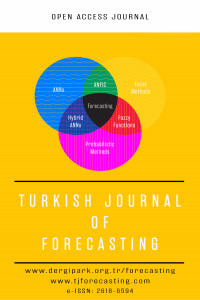Prediction of the Premium Production of Some Insurance Companies Operating in Turkey with Artificial Neural Networks
Prediction of the Premium Production of Some Insurance Companies Operating in Turkey with Artificial Neural Networks
Insurance premium production volume, Artificial neural networks, Prediction, Time Series Training Algorithm, Activation Function,
___
- [1] Hawley, D. D., Johnson, J. D., & Raina, D. (1990). Artificial Neural Systems: A New Tool for Financial Decision-Making. Financial Analysts Journal, 46(November/December), 63-72.
- [2] Wilson, R. L., & Sharda, R. (1994). Bankruptcy Prediction Using Neural Networks. Decision Support Systems, 11, 545-557.
- [3] Titterington, D.M. Bayesian methods for neural networks and related models. Stat. Sci. 2004, 19, 128–139.
- [4] Kitchens F., Harris T. (2015). Genetic Adaptive Neural Networks for Prediction of Insurance Claims, International Journal of Engineering and Advanced Research Technology, 1(6), 27-30.
- [5] Bayır F. (2006). An Application on Artificial Neural Networks and Predictive Modeling (Yapay Sinir Ağları ve Tahmin Modellemesi Üzerine Bir Uygulama), Master Thesis, Istanbul University, Istanbul.
- [6] Dogan G. (2010). Portfolio Evaluation in a Private Insurance Company in Turkey Using Artificial Neural Networks (Yapay Sinir Ağları Kullanılarak Türkiye’deki Özel Bir Sigorta Şirketinde Portföy Değerlendirmesi), Master Thesis, Hacettepe University, Ankara.
- [7] Uslu Ç. S. (2011). Comparison of artificial neural network estimations with time series analysis (Zaman Serisi Analizi İle Yapay Sinir Ağları Kestirimlerinin Karşılaştırılması), Master Thesis, Mimar Sinan Fine Arts University, Istanbul.
- [8] Bahia I.S.H. (2013). Using Artificial Neural Network Modeling in Forecasting Revenue: Case Study in National Insurance Company/Iraq, International Journal of Intelligence Science, 3, 136-143.
- [9] Sakthivel K.M., Rajitha C.S. (2017). Artificial Intelligence for Estimation of Future Claim Frequency in Non-Life Insurance, Global Journal of Pure and Applied Mathematics, 13,6.
- [10] Çetinkaya T., (2019). Life insurance primary production comparing methods forecasting primary production for future years (Hayat Sigortası Prim Üretimlerini Tahminleme Yöntemlerini Karşılaştırarak Gelecek Yıllar Prim Üretimini Tahminleme), Master Thesis, Marmara University, Istanbul.
- [11] Høysæter D., Larsplass E. (2020). Predictive modelling of customer claims across multiple insurance policies, Master’s thesis in Business Analytics MSc in Economics & Business Administration, Norwegian School of Economics.
- [12] Werbos P.J. (1974) Beyond Regression: New Tools for Prediction and Analysis in the Behavioral Sciences.
- [13] Rumelhart, D.E., Hinton, G.E., & Williams, R.J. (1986). Learning internal representations by error propagation. Doi:10.1016/B978-1-4832-1446-7.50035-2
- [14] Elman J.L. (1990) Finding Structure in Time, Cognitive Science, Vol.14, pp.179-211.
- Yayın Aralığı: Yılda 2 Sayı
- Başlangıç: 2017
- Yayıncı: Giresun Üniversitesi
Ahmet Furkan BAYRAM, Caglar GURKAN, Abdulkadir BUDAK, Hakan KARATAŞ
Ali ÖZDEMİR, Aytuğ ONAN, Vildan ÇINARLI ERGENE
Ahmet Furkan BAYRAM, Caglar GURKAN, Abdulkadir BUDAK, Hakan KARATAŞ
